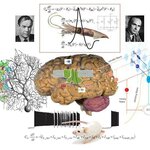Neuroscience

During the short, dreary days of winter, some people feel tired and oversleep, they are depressed and irritable and have trouble concentrating. But once spring arrives, they say they feel fine.
4 percent of the American public say they suffer from this seasonal affective disorder (SAD), a type of depression that occurs during the same season each year.
Biologists know that variations in the amount of sunlight a person receives and her or his circadian clock play a role in the disorder and some have proposed that the neurotransmitters serotonin and melatonin may be involved. However,…

Virtual reality (VR) equipment has tended to be cumbersome and expensive, all heavy headsets and awkward gloves.
Until recently it’s been beyond the reach of the home consumer, but with the appearance of Oculus Rift (since bought by Facebook), Microsoft’s HoloLens, and even DIY options such as Google Cardboard, it seems VR is coming to a living room near you soon.
But there’s a bigger problem with VR than just cost: virtual reality tends to make users feel sick. Simulator sickness, symptoms of which include dizziness, nausea, sweating and disorientation, is a well-known problem for virtual…

People with depression or bipolar disorder often feel their thinking ability has gotten "fuzzy", or less sharp than before their symptoms began, and a new study published in BRAIN finds that the effect is real - and rooted in brain activity differences that show up on advanced brain scans.
The authors also say that these conditions both fall on a spectrum of mood disorders, rather than being completely unrelated. The study is of tests they gave to 612 women, more than two-thirds of whom had experienced either major depression or bipolar disorder. The researchers also present data from…

Researchers have succeeded in reconstructing the neuronal networks that interconnect the elementary units of sensory cortex, called cortical columns. A key challenge in neuroscience research is identifying organizational principles of how the brain integrates sensory information from its environment to generate behavior. One of the major determinants of these principles is the structural organization of the highly complex, interconnected networks of neurons in the brain.
To help, researchers constructed anatomically-realistic 3D models of such neuronal networks in the rodent brain.
The…

People with insomnia and other sleep problems also report increased sensitivity to pain, reports a new study.
The study included more than 10,400 adults from a large, ongoing Norwegian health study. Each subject underwent a standard test of pain sensitivity--the cold pressor test--in which subjects are asked to keep their hand submerged in a cold water bath.The effect on pain tolerance appears strongest in people who suffer from both insomnia and chronic pain, who may benefit from treatments targeting both conditions.
Subjects were asked about various types of sleep impairment,…

There has been excitement among researchers in recent years that playing certain video and computer games may strengthen core components of cognition, helping us to make quicker decisions, think more fluidly, and avoid harmful distractions.
Although practice makes perfect, any improvement is usually limited in its scope. So, practising the piano does not make you a better basketball player, but it might help your xylophone playing. However, playing basketball should have cardiovascular benefits that improve performance not only on the court, but also in the swimming pool. Likewise, gaming…

Transcranial direct current stimulation, using a weak electric current in an attempt to boost brainpower or treat conditions, has become popular among cognitive do-it-yourselfers and the neuroscience equivalent of people selling dietary supplements, but a new University of North Carolina School of Medicine study urges caution that should be common sense.
New work found that electric brain stimulation had a statistically significant detrimental effect on IQ scores. Using less common alternating current stimulation - so-called tACS - could be a better approach. Tesla beats Edison once again.…

If you have ever wondered why you need to snack more at night and many people don't, there may be a neuroscience answer: areas of the brain that get a satiety "food high" may not get it in the evening.
In a new study, exercise professors and a neuroscientist used MRI to measure how the brains of college students respond to high- and low-calorie food images at different times of the day. Functional MRI took pictures of the brain activity of study subjects while they viewed images of food. The participants viewed 360 images during two separate sessions held one week apart--one…

Alcohol is used and sometimes abused by millions of people worldwide, though how it acutely changes brain function, to cause inebriation, and then chronically changes brain function, to cause dependency, remain largely unknown.
Since dependence can destroy lives and families, the goal has been to understanding the mechanisms of it in order to to countering it. A “sobriety pill”, for example, would have immense medical, sociological and commercial potential.
It is likely that the different aspects of the alcohol response are mediated by alcohol’s action upon different molecular targets…

The brain function of people addicted to cocaine is different from that of people who are not addicted, and often linked to highly impulsive behavior. The variation in the way that different regions of the brain connect, communicate and function in people addicted to cocaine is an observation published in NeuroImage: Clinical.
Cocaine addiction exists among an estimated 800,000 people in the U.S. alone, but despite decades of attempts, FDA-approved medications for cocaine use disorder remain to be discovered.
People addicted to cocaine are highly impulsive and prone to acting…